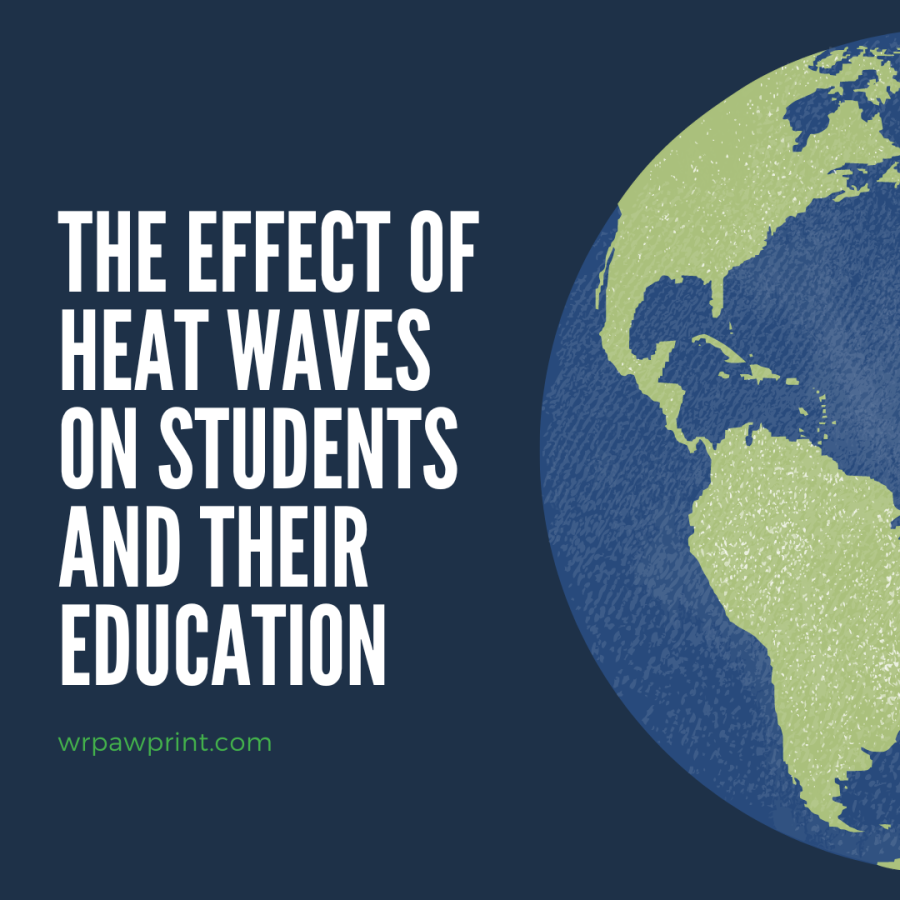The effect of heat waves on students and their education
October 14, 2022
Summer is often a beloved season for many people, as it’s a great time for long trips, beach visits and much more.
However, this year, the summer season has turned out to be unlike any other. For the first several weeks of September, California came under a scorching heat wave after experiencing a relatively mild summer season through June and July.
The heat wave was devastating, particularly in the West. According to CBS News, in California, average temperatures over the Labor Day weekend were more than 20 degrees higher than average, which has led to new electricity and water restrictions across the state.
Unfortunately, as explained by CBS, the heat wave is just one of countless abnormal weather events that have been occurring worldwide, which include severe flooding, droughts and enormous fires. Altogether, these crises all point to one main problem: climate change.
The Paw Print decided to take an in-depth look at this problem.
What causes climate change?
According to the United Nations, “Climate change refers to long-term shifts in temperatures and weather patterns. These shifts may be natural, such as through variations in the solar cycle.”
Over the course of human history, dating back to the Industrial Revolution, the climate changes we are experiencing today have been caused by human activity.
According to National Geographic, industrialization revolutionized production—powered mainly by coal—and it transformed human lives. However, at the same time, these changes came with a price.
As explained by the Environmental Protection Agency (EPA), the coal that humans have been using to power production has released enormous amounts of gas, particularly carbon dioxide, into the atmosphere. These gases are heat-trapping, and as they accumulate in the atmosphere, they trap more heat, warming the planet through the Greenhouse Effect.
Especially over the last several decades, climate change has begun to intensify otherwise natural weather patterns, playing a role in the weather changes we are experiencing today, according to the EPA.
According to Earthjustice, a nonprofit organization bringing awareness to climate issues, global warming has increased the frequency of everything, from wildfires, to droughts, hurricanes, flooding and winter storms. These conditions have dried out the environment, creating more frequent fires and droughts, and have increased evaporation into the atmosphere, making storms and hurricanes more prone to occuring.
In the western United States, these changes have made fires, droughts and heat waves far more common, including the sweltering heat wave the western United States experienced over the first several weeks of September.
Not only have heat waves drastically affected the economy and infrastructure, it has also had a significant impact on young people.
How do heat waves affect student health and education?
The heat wave has drastically affected the education and health of students across LA County. These effects have been especially noticeable in the classroom, with many students facing exhaustion in the heat, which, during the latest wave, often reached 100℉ by mid-day, according to the Los Angeles Times.
“Most of the students in my class have overall good health, however, there are a few that seem slightly affected by the temperature,” noted Ms. Whitney-Coe, West Ranch cheer advisor and Marine Biology teacher. “Those that are affected seem more tired but this applies to the afternoon students and not the morning students.”
Working during the afternoon, in which temperatures often reach their peak, is a struggle for many in the extreme weather, and has taken a noticeable toll on academic success.
Senior Shefali Breitbach, captain of the cross country team, explained that “the heat has increased stress, overall. When a workout didn’t go well, or we had to cut something, it was very stressful, because we didn’t feel like we were improving. For me, running is my way to release stress, but with the heat, it was difficult, because that just added more stress, and it took a toll on my education.”
“You would see a lot more students lethargic from the heat,” added Mr. Varner, AP Psychology teacher and West Ranch football coach. “That probably relates even more to not being properly hydrated, while still maintaining the same level of caffeine they drink in the mornings as opposed to getting water… I think it’s all combined… caffeine dehydrates you, and if you’re not drinking enough water anyway during spikes into the triple digits, I think it all comes together in a negative way for students.”
Working in the heat, particularly in extreme temperatures, can have a significant impact on overall health, which can affect a student’s performance and education.
According to the World Health Organization, the human body has the ability to maintain a delicate balance of body temperature: a process called homeostasis. Extreme heat can compromise a person’s ability to maintain this balance.
As a result, it can worsen already severe chronic conditions, which is why heat has an extreme effect on the already ill or immunocompromised. However, it can still affect healthy people of all ages and cause devastating illnesses, such as exhaustion, heat stroke and hyperthermia.
These heat-related symptoms can cause rates of learning to plummet as the temperature rises, as heat can cause a lack of energy and difficulties with concentration, as explained by Stanford University. In addition, data gathered from across America in the study shows a clear correlation between higher temperatures and lower scores on standardized tests.
Undoubtedly, climate change has made this crisis worse. As temperatures slowly rise and extreme heat and other weather patterns become more common, educational gaps have widened significantly.
The changes in weather patterns and overall day-to-day temperatures have also had a profound impact on sports, including the athletics programs at West Ranch.
Breitbach described how the heat has affected the cross country team’s practice and performance: “Because cross country is a completely outdoor sport, and we can’t really do anything inside, the heat definitely was a challenge. Workouts that we had planned had to be changed, we had to run at different times and it messed up our whole routine, which is really important for running.”
“Also, as a runner, you have to stay hydrated all the time, and the heat just takes all that water away, so it’s really hard to maintain that,” Breitbach added. “The amount of bottles of water I had to drink during class was unreal. Honestly, we were just waiting the heat out, and we tried to practice in the morning as much as possible, but it’s just tricky with everyone’s schedules.”
Staying outside in the heat, particularly when engaging in high-intensity activities like sports can have a notable effect on the human body. As explained by the National Institutes of Health, exercising in the heat has a clear association with diminished athletic performance, even possibly causing severe illness. Working in the heat can be incredibly dangerous, as it can easily draw out crucial water that the body needs, leading to exhaustion, loss of consciousness or heatstroke.
Mr. Varner explained, “We had a mandatory stoppage of activities during the day during the heatwave, and we were only allowed to practice between 6 a.m. and 8 a.m. That greatly affected students— having to get up early, and then going through a whole day of educational classes. And then, we were allowed to go from 6 p.m. to 8 p.m., to stay out of the elements during the hottest point of the day.”
“This has been a huge change for sports,” Ms. Whitney-Coe agreed. “We are constantly checking the temperatures to make sure that we are not practicing or playing in extreme heat or during a high heat index. Because of the heat, sports have been asked to change the time of day in which they practice and this puts a strain on space.”
The devastating heatwave, and other extreme weather conditions have caused confusion and concern among many, and it can be a significant source of stress and anxiety. Nevertheless, as heat waves across the country are predicted to become more extreme, there are many ways for people to protect themselves and stay safe.
What students can do to stay safe in heat waves
Undoubtedly, heat waves can be incredibly dangerous for humans, and according to CNN, as the climate crisis worsens over time, these effects are only going to become more severe. Of course, there are always steps everyone can take to protect themselves from extreme weather, and stay safe in the heat.
Firstly, wearing proper clothing and protection is essential.
Mrs. Stephens-Carrillo, West Ranch’s school nurse, pointed out several important changes that students can make to protect their health: “I do tend to see a lot of the students who come in with heat-related issues [doing several things incorrectly]. One, they’re not drinking water or eating like they’re supposed to. The other thing that a lot of teens do is that they’re wearing sweatshirts in the heat, and that isn’t good. It’s ok to have a long-sleeved shirt on to cover up from the sun, but you don’t want to wear a sweatshirt, because that makes you overheat.”
According to the Red Cross, having good protection from heat exposure is incredibly important. With regard to clothing, it’s essential to wear loose, lightweight clothes, in light colors that absorb less heat. It is also crucial to wear sunscreen, which is a useful tool to protect the skin against harmful rays from the sun.
In addition, another essential tool to fight the heat is water.
Mrs. Stephens-Carrillo explained that “I always tell all the students who come in here that are overheated or asking for water that they need to drink as much water as they can… They also need to make sure that they eat something, because when it’s too hot, and they’re not eating and drinking, this can lead to more health issues.”
According to the Red Cross, the average person requires three-quarters of a gallon of water each day. This water is key in replenishing the body, especially in the heat, when dehydration can quickly occur. Without hydrating prior to being in the heat, serious illnesses and side effects can occur, such as heat cramps, exhaustion and heat stroke.
In addition, it is important to work at the right times of the day. During the peak heat of the day, it is better to work in an air conditioned space, or stay in the shade if being outside is necessary. Also, it is recommended to avoid working out in the heat, which creates a necessity to move workouts to early mornings or evenings.
One of the most important things to do is to know one’s limitations in the heat, and allow the body to rest.
Breitbach concluded, “The biggest thing is that if you aren’t feeling it, or it isn’t working, it is better to stop rather than try and push yourself past your limit. We did have some instances on the team where a few girls passed out or threw up, so it was very dangerous. You just have to remember that it’s better to take care of yourself, rather than getting a few extra miles in or getting a harder workout in.”
Navigating school and everyday life during a heatwave can be difficult and stressful. However, it is absolutely essential to take time to recover, and keep the body fueled in extreme heat. Cats, be sure to follow these tips to stay safe in the heat!


